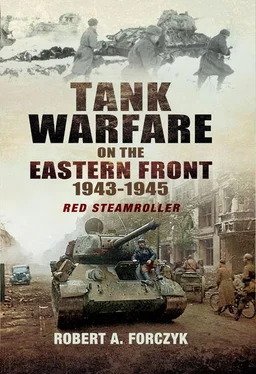On the morning of 13 July, Hitler summoned both von Manstein and von Kluge to his Wolfsschanze headquarters in East Prussia to discuss Zitadelle . Von Kluge stated that Model’s 9. AOK could no longer attack and had its hands full dealing with the Soviet counter-offensive. Von Manstein was more upbeat, claiming that ‘victory on the southern front of the Kursk salient is within reach. The enemy has thrown in nearly his entire strategic reserves and is badly mauled. Breaking off action now would be throwing away victory!’ {123} Hitler was nervous and pensive, as he often was in moments of crisis. Ignoring von Manstein’s prediction of victory, Hitler spoke of the Allied landing in Sicily on 10 July and the danger to Italy, which he believed would require the transfer of some forces from the Eastern Front to prevent this situation from becoming worse. In essence, Hitler was unsettled by the heavy losses and the relative lack of success – as Guderian had predicted – and was unwilling to put any more resources into Zitadelle . Thus, he ordered Zitadelle halted, but granted von Manstein permission to temporarily continue local operations to finish off the fight around Prokhorovka.
On 13 July, Rotmistrov’s 5 GTA remained on the defensive and was able to repulse a limited attempt by LSSAH to advance closer to Prokhorovka; the LSSAH suffered another 326 casualties for no gain. North of the Psel, the 5 GMC and the 5th Guards Army mounted a counter-attack that convinced Bochmann’s Panzergruppe to withdraw to the bridgehead under heavy pressure. However, the main action on 13–14 July was the effort by II.SS-Panzerkorps and III.SS-Panzerkorps to encircle and eliminate the Soviet 48th Rifle Corps (48 RC). The capture of the Rzhavets bridgehead had made this Soviet formation vulnerable and Bäke led a fierce attack with III. Panzerkorps’ remaining panzers against the 81st Guards Rifle Division while Das Reich struck the other side of the mini-salient. Although the 2 TC and 2 GTC fought to delay the German armoured pincers from closing behind the 48 RC, this effort failed and Vatutin ordered 48 RC to retreat. Around 0500 hours on 15 July, the II.SS-Panzerkorps and III. Panzerkorps belatedly achieved a link-up at the village of Shakhovo, but the 48 RC had already slipped out of the salient just before the pincers closed.
The Meaning of the Battle of Kursk
Kursk is a highly controversial battle. Right after the battle, Marshal Vasilevsky wrote an after-action report that attempted to conceal the truth about 5 GTA’s losses, but Stalin soon found out and was enraged. Initially, Stalin wanted to have Rotmistrov tried and executed, but eventually Vasilevsky softened his response. Instead, Stalin put Politburo member Georgy M. Malenkov in charge of a commission to determine the reasons why the 5 GTA’s counter-attack had failed; Malenkov’s report was sealed, but it concluded that the 5 GTA’s attack was a model of an unsuccessful operation. {124} Rotmistrov was allowed to remain in command of 5 GTA until mid-1944 but afterwards he was kicked upstairs into various high-level desk jobs.
In the 1960s, Kursk was not well known in the West. Initially, popular memoirs by Guderian and Friedrich Wilhelm von Mellenthin depicted Zitadelle as a decisive defeat, but this view was challenged by von Manstein’s memoirs that complained about Hitler ‘throwing away a victory’ in his decision to cancel Zitadelle . Paul Carell echoed von Manstein’s claims in his well-known books written in 1964–70 and he helped to shape the early historiography of Kursk with his contention that von Manstein had indeed been on the cusp of a great victory when Hitler pulled the rug out from under his feet. [31]Carell’s histories also helped to create a heroic mythology around the Waffen-SS troops involved in Zitadelle , which retains great credibility even today. The Soviet version of Kursk began appearing with the multi-volume History of the Great Patriotic War in 1958 and Rotmistrov’s inaccurate memoirs in the 1960s. This white-washed version of Kursk was designed to conceal the Red Army’s disproportionate losses in the battle and Nikita Khrushchev’s (by then First Secretary of the CPSU) role in the disastrous commitment of Rotmistrov’s 5 GTA. Soviet accounts created a highly mythic account of Prokhorovka as ‘the greatest tank battle in history’ and Grigoryi A. Koltunov claimed that, ‘in one day the Germans lost more than 350 tanks and over 10,000 officers and men.’ [32]Soviet historians regarded Kursk as determining the outcome of the war in the East, stating that, ‘the Germans had been bled white’ and had permanently lost the initiative. {125} This version of the battle was melded with Carell’s and influenced popular as well as academic histories written about Kursk until the mid-1990s. Even seasoned authors such as Albert Seaton, John Erickson and David Glantz accepted embellished accounts of Kursk as historical fact. In 1995, Glantz’s landmark one-volume account of the Eastern Front, When Titans Clashed , still claimed that the Germans lost 320 tanks and assault guns at Prokhorovka. {126} At that point, two things happened which reduced most previous historiography on Kursk to pulp: the records of II.SS-Panzerkorps became available, and the Soviet-era archives were partly opened after the collapse of the Soviet Union.
Books written based upon this new information by Zetterling, Nipe, Glantz and Zamulin have given a much more realistic interpretation of Kursk, but still suffer from biases. Zetterling took a materialistic approach and provided a great statistical analysis of the battle based upon better – but not perfect – numbers. He used Totalausfalle numbers of tanks to show that the German armour was not crippled at Kursk and still retained the ability to advance, particularly if Hitler had allowed Nehring’s XXIV Panzerkorps to reinforce Hoth. However, Zetterling’s numbers are somewhat disingenuous, in that he suggests that tanks that were not completely destroyed were still useful to the Germans since they could be repaired, but in fact tanks which had been repeatedly hit by anti-tank fire and mines were increasingly ‘degraded’ to the point that they had only marginal combat value. He also fails to put the heavy German personnel losses in perspective: by 13 July von Manstein’s Panzer-Divisionen had lost a large number of tactical leaders, including three Panzer-Regiment commanders and multiple battalion and company commanders; the loss of these leaders negatively impacted unit morale and motivation. The Tiger tank units were particularly hard hit; for example, the s. Pz.Abt. 503 had suffered about 40 per cent personnel casualties and the Waffen-SS separate Tiger tank companies had lost multiple commanders. Personnel losses tend to hit armoured units particularly hard, since experienced leaders, gunners and drivers cannot be easily replaced by rear-echelon personnel or partly-trained replacements. What Zetterling missed was that while the Germans were able keep their Totalausfalle numbers low in relation to Soviet losses, the repaired tanks and remaining crews did not have anything near the same efficiency as the tanks and crews at the start of the offensive.
In 1996, amateur historian Georg Nipe wrote Decision in the Ukraine , which used some of the new numbers from German records, but fell into the trap of endorsing von Manstein’s claims about Zitadelle as a ‘lost victory.’ Without reference to any Soviet records, Nipe claimed that Rotmistrov lost 600–650 tanks at Prokhorovka on 12 July and that the Germans had actually gained numerical superiority in tanks in this sector and that the commitment of Nehring’s XXIV Panzerkorps may have been decisive. {127} In 1999, David. M. Glantz wrote the best available single-volume history of the Battle of Kursk, based upon a good mix of Soviet and German records. However, Glantz failed to offer much insight into why major Soviet armoured counter-attacks on 8 and 12 July failed so badly, or why the II.SS-Panzerkorps was able to penetrate Vatutin’s defensive lines so quickly. Nipe returned to the fray in 2011 with Blood, Steel and Myth , which focused even more narrowly on II.SS-Panzerkorps. Although he does not use Soviet records, Nipe added great detail on the operations of the Waffen-SS and concluded that the number of tanks involved in Prokhorovka was far fewer than previously stated, particularly on the German side. Indeed, it is now clear that no more than 210 German and 642 Soviet tanks participated in the fighting on 12 July 1943, which is quantitatively smaller than some of the tank battles around Smolensk in 1941 and Voronezh in 1942. Distancing himself from earlier claims, Nipe also concluded that the capture of Prokhorovka would not have made any difference and the commitment of XXIV Panzerkorps would not have been decisive. Finally, Valeriy Zamulin’s ground-breaking Demolishing the Myth (2011) has revealed a treasure-trove of Soviet records about the battle that provide a much more realistic interpretation.
Читать дальше








![John Stieber - Against the Odds - Survival on the Russian Front 1944-1945 [2nd Edition]](/books/405234/john-stieber-against-the-odds-survival-on-the-russian-front-1944-1945-2nd-edition-thumb.webp)



